Enterprise AI leaders must focus on verticalized AI solutions
Enterprise adoption of the Triple-A Trifecta of AI, analytics, and automation, is likely to peak in the next two to five years. A recent HFS survey of 262 analytics leaders, 80% of respondents plan to invest and scale deployments of AI, analytics, and automation technologies in this timeframe.
The survey also highlighted the fact that although operational cost reduction has remained a basic outcome of AI and automation, several business leaders are focusing increasingly on using AI and automation to drive revenue growth and improve the strategic competitive advantages of their businesses.
For example, a recent HFS study with 590 enterprise AI & automation leaders revealed that when asked about their adoption priorities for initial levels of AI and intelligent automation solutions-the majority of respondents chose revenue and top-line-impacting objectives rather than just focusing on operational efficiencies, as shown in Exhibit 1.
Further, the study revealed that
- The leaders leverage intelligent automation to drastically improve their revenue growth through increased sales and innovate faster and better to improve delivery efficiency.
- A similar chunk of the leaders’ responses shows their focus on improving customer experiences, as they deem customer experience to be the pathway to gold by gaining differentiated visibility in the market and thereby sustaining competitive advantage.
Exhibit 1: Leaders prioritize top line metrics over the bottom line
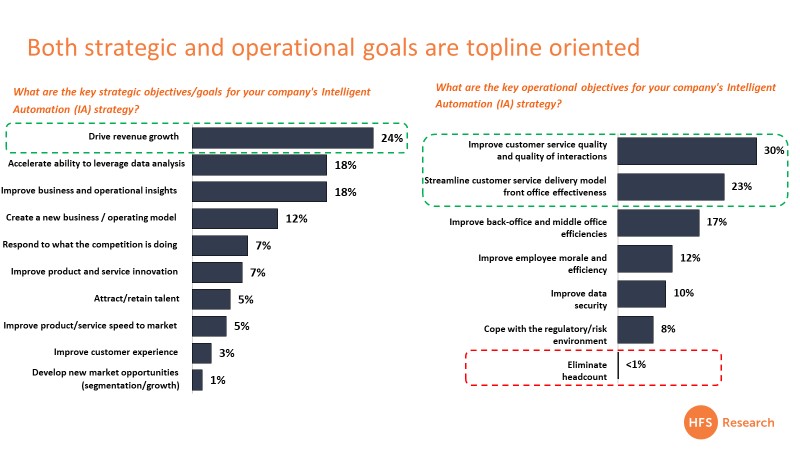
Source: HFS Research in Conjunction with KPMG, State of Intelligent Automation, December 2018
Sample = 590 Business Leaders including 100 C-level executives
To achieve these strategic objectives of faster, better innovations and transformational customer experience, it is imperative that enterprise AI leaders focus on the contextual aspects of data and domains that are unique to each vertical the enterprise operates in. For example, both innovations and customer experience relevant for an enterprise in the travel and tourism sector will be quite different from those for enterprises in the banking and insurance sectors.
While the building-block technologies may remain similar, their contextualization with relevant training datasets and domain ontologies and applications will be critical to the success of these AI use cases to drive drastic and exponential business outcomes in terms of top-line growth and customer experience.
Therefore, among the three critical technology elements of any enterprise AI solutions (data, domain, and algorithms), in-depth knowledge and understanding of the domain is the most critical success factor of any business application of AI. Data obviously reflects the structure and content of the domain, in terms of the entities involved, their relationships, and causality (e.g., correlation, covariance, and regression among different entity attributes and dimensions). Also, each business domain has a different set of implicit and explicit rules, either coming from their regulatory bodies or implied and defined by their markets and economics. It is crucial that the enterprise AI practitioners understand the internal workings of data and domains in each organization to make the AI solutions work in a business-relevant manner and to improve the top-line metrics of the company. Verticalizing AI solutions and enriching them deeply with the context and domain knowledge is imperative for the success of AI.
However, it is much easier said than done. As several enterprise AI leaders pointed out to us, enterprises face two significant challenges to their ability to build and leverage verticalized AI solutions:
- Over-enthusiasm and over-focus on the complex AI technologies and algorithms rather than focusing on understanding the targeted problem areas and their context and domains better;
- Lack of in-depth know-how and domain expertise that is necessary for building AI solutions.
How to build verticalized, context-rich AI solutions leveraging the generic components available: The NIIT Technologies approach
NIIT Technologies is a leading global IT solutions organization with over 10,000 employees serving clients across the Americas, Europe, Asia, the Middle East, and Australia. The company is hyper-specialized on industries that offer domain-rich solutions and services for its clients’ businesses, with leading-edge capabilities in cognitive and AI, automation, integration data and analytics, cloud, and digital.
Backed by the strategy of “Transform at the Intersect” and making emerging technologies beyond just digital involute, the company has firmly positioned itself as a post-digital firm. At the intersection of deep domain expertise and digital and post-digital technology capabilities, the company is driving transformation for clients by deploying them in the context of chosen industry sub-segments. It is interweaving cognitive and AI, data, automation and integration, and cloud technologies to make them involute and maximize value creation. The strategy has resonated well with its clients and helped the company differentiate actively in the market.
Enterprise AI leaders must leverage AI solutions at the intersection point of horizontal technical AI capabilities and vertical-specific depth
NIIT Technologies’ AI approach to solutions focuses on cross-leveraging its horizontal AI technology capabilities with its deep understanding of its focused verticals of travel and transportation, banking and financial services, and insurance, through the company strategy of “Transform at the Intersect,” where it brings differentiated capabilities that leveraging strengths in the focus verticals. The transformation organization not only focuses on familiar AI technology capabilities but also leverages a best practice approach in four key steps:
- Identify business needs and potential targeted impact of solutions on critical outcomes.
- Identify the solution approaches that will be utilized in building the solutions, leveraging various AI and automation techniques as needed.
- Evaluate and understand the technical implications of the solutions.
- Finally, articulate the most optimal solution that reflects the client organization’s critical priorities and strategic objectives adequately.
Each of these steps requires an in-depth understanding of the vertical and the domain that the enterprise operates in. These steps are imperative for analyzing the data attributes and relationships, designing the use case, the predictive decision, classification, recommendation models, or in presenting these models in a user-friendly, human-interpretable manner that can make more sense to business users than technical geeks or data scientists.
Transforming at the intersect has three essential characteristics
Three distinct aspects and advantages of this intersection-focused approach are
- The approach starts from the business problem downward, not from component technology selection upward. Therefore, by design, this approach is meant to start from the business users’ and business process owner’s personas and not from technical developers and AI experts’ viewpoints. This approach naturally makes the solutions prioritize the domain and business issues and can deeply reflect upon users’ priorities rather than technical priorities and constraints.
- The approach also balances the business priorities with technical feasibility; it doesn’t naturally assume that all business problems will have to be solved by AI or even that all business problems will require AI in the first place.
- Once the domain, context, and problem are sufficiently analyzed and understood, only then does the approach delve into selecting techniques and technologies to be used, including those from the AI and automation capabilities portfolios. This approach ensures that choices of technologies and techniques are not confined or constrained by the tech experts’ comfort zones but are rather determined by the needs of the problem.
For example, one of the senior customer technology leaders from a global travel and tourism industry house was explaining how critical it is for their AI implementation partners to understand the unique nature of their vertical and specifically what customer experience means in this vertical, where the customers stay with them for 10 to 15 days of holidays at a stretch and build their impression across all the facilities that they avail and consume. Dealing with customer feedback in near real-time has a direct impact on the market image, market share, and profitability of the entire company. NIIT Technologies, as the travel enterprise’s AI deployment partner for this use case, understood this criticality from the inception of the project, and, therefore, the focus of the program always remained the critical business outcome of customer feedback, using various AI and ML techniques for actionable response management and analytics.
Enterprise AI leaders must prioritize AI use cases in their own verticals that have a direct impact and implications on business outcomes
A focused approach toward visible and demonstrable outcomes helps us to create early success stories as proof-points, which are very critical for the long-term success of both AI and the Triple-A Trifecta. Demonstrated experience is especially important given that currently, a majority of end-user companies are still in experimental phases with AI and have been doing extensive pilots and POCs to see how the usecases work. To make the AI journey transformational and sustainable, these pilots and POCs need to be directly impacting outcomes that are critical to businesses.
For example, NIIT Technologies focuses on building AI solutions across the following verticals, where it has clear domain strength over its competition, based on the critical business outcomes and priorities of the verticals. Three critical aspects of the value proposition for the AI solutions are:
- Catalog of cognitive use cases for focus verticals of banking and financial services, insurance, travel, and transportation.
- Includes industrialized use cases, which apply to all verticals.
- Help customers to jump-start and accelerate their AI transformation journey.
Exhibit 2: NIIT’s catalog of cognitive use cases can meet customers’ needs across domains
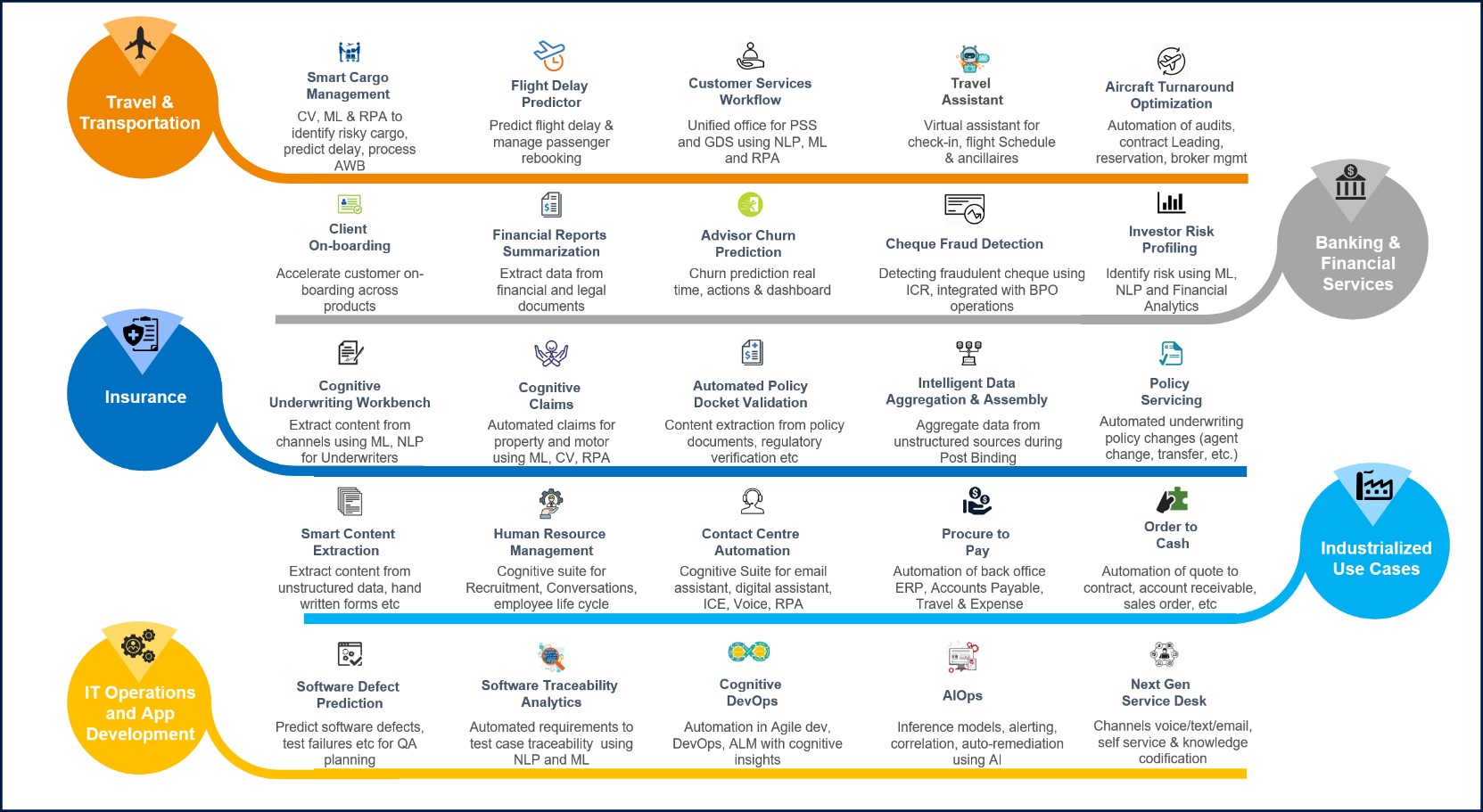
Source: NIIT Technologies
Solutions in travel and transportation demonstrate NIIT’s expertise
In the travel and transportation domain—one of NIIT Technologies’ main focus areas—the company’s solutions are fully reflective of its understanding of the priorities and criticalities of the vertical and hence are imperative to clients’ realization of their critical business outcomes.
- The Travel Assistant is a voice- and text-based virtual assistant for booking flights and ancillary tasks, including flight check-in, managing bookings, and tracking loyalty points. NIIT optimized the language-specific model on utterances and development lifecycle by leveraging domain knowledge and integration capabilities, which led to an enhanced end-user experience and a faster time to market.
- Aircraft Turnaround Optimization manages tracking aircraft events during turnaround, prediction, and analytics. This use case reflects a key priority for both profitability and operational efficiency of any airline company, along with the integration of automatically captured events and downstream airline systems like the operational databases and resource management systems.
- The Smart Cargo Management use case brings efficiencies across the cargo lifecycle, including identifying risky cargo using computer vision, predicting cargo shipment delays using machine learning, and processing the logistics workflows. This use case helps airlines and ground handlers with effective regulation compliance and enhanced operational efficiencies.
- The Flight Delay Predictor helps an airline predict flight delays and provides a digital channel to manage the disruptions and customer bookings that result from them. This is a direct revenue- and market-share-impacting use case because it involves the most critical service aspect of any airline: the passenger experience.
A thorough understanding of the banking and financial services domain meets customers’ needs
Similarly, in another specialty vertical for NIIT Technologies, the banking and financial services domain, prominent use cases reflect the company’s complete understanding of the vertical.
- The Client On-boarding use case provides a framework to accelerate customer on-boarding and enhance operational efficiency. While operational efficiency is a sure-shot gain when this use case is deployed, there are knock-on benefits, including improved customer experience, process consistency, and quality; these reduce both errors and rework from the customers’ viewpoint and for the process owners. Faster customer on-boarding also means that the economic value of the relationship kicks in quickly, benefitting both participating entities, as the time-to-go-live of their relationship gets faster.
- Fraud Cheque Detection helps detect fraudulent checks with intelligent character recognition and advanced image analysis capabilities using AI techniques such as convolutional neural networks and convolutional sparse coding.
- Financial Reports Summarization employs automated extraction of relevant data from financial and legal documents in different formats, structures, and locales using NLP and ML, processing data, and integration with risk systems. The data sources include financial statements based on GAAP and IFRS standards, which help financial institutes apply operational efficiencies to lending and risk management
- Investor Risk Profiling involves cognitive-led risk profiling of investors, which is a mandated process for investment management and lending. Machine learning utilizes alternate data such as e-com transactions, bank statements, and investment footprints to help customers leverage enormous data insights for optimized decision making.
The insurance vertical is NIIT Technologies’ largest market
In the insurance space, NIIT Technologies’ largest vertical, some of the use cases deployed are
- The Cognitive Insurance Workbench improves underwriters’ productivity and ability to handle more requests and focus on high-value tasks. Insurance company underwriters are challenged to process the statements of values and the policies and contracts, which are high volume transactions. This solution extracts the required content from multiple input channels using machine language (ML) and natural language processing (NLP).
- Cognitive Claims automates claims for motor and property using computer vision, ML, and robotic process automation (RPA), and it supports multiple digital channels. Customers can use smartphones and handheld devices to interact with the system for straight-through processing in compliance with insurance-provider-specific rules, which can also bring in exponential gains in efficiencies in manual processing.
Once the critical business priorities and outcomes of the verticals are well understood and reflected in selected use cases, reusable AI modules and components help build and deploy them faster.
Reusable AI modules by domain can accelerate the client journeys
This is the final step—where the rubber hits the road—when the use cases that are prioritized and designed by the verticals are now built and deployed. At this stage, reusability and optimal modularity win the race. Reusable components and modules are bundled under Tron Smart Automation, which is NIIT Technologies’ AI-led automation platform that leverages artificial intelligence, analytics, and RPA to deliver enterprise-wide automation. The horizontal components are applicable across enterprises in both IT and business processes. The business and vertical focus comes in the “Business Process” area, where the use cases as described in the context of the verticals essentially reflect priorities across business operations and infrastructure automation.
The underlying implementation layer consists of the component modules, namely the technology spectrum spanning across deep learning techniques in AI, be it in unstructured text or image processing; chatbots using natural language processing capabilities of AI; predictive machine learning models that often leverage huge volumes of structured or semi-structured data and complex events data, in supervised learning mode; and RPA for automating tasks and processes.
Last but not the least are the foundational technology layers where these components come from, ranging from the bot development frameworks and environments provided by the most popular RPA technology providers like Automation Anywhere and UIPath; deep learning algorithms from Microsoft, AWS, and Artificial Solutions; then self-learning knowledge-graph-based deep AI techniques from arago; infrastructure automation, self-healing, and autonomous orchestration engines from the likes of Service Now and Nanoheal; and Accelerated Data science leveraging H2O and other open source technologies for data ingestion, data wrangling, deployment, and MLOps across the lifecycle.
Exhibit 3: The technology components and layers of the end-to-end AI and automation solutions
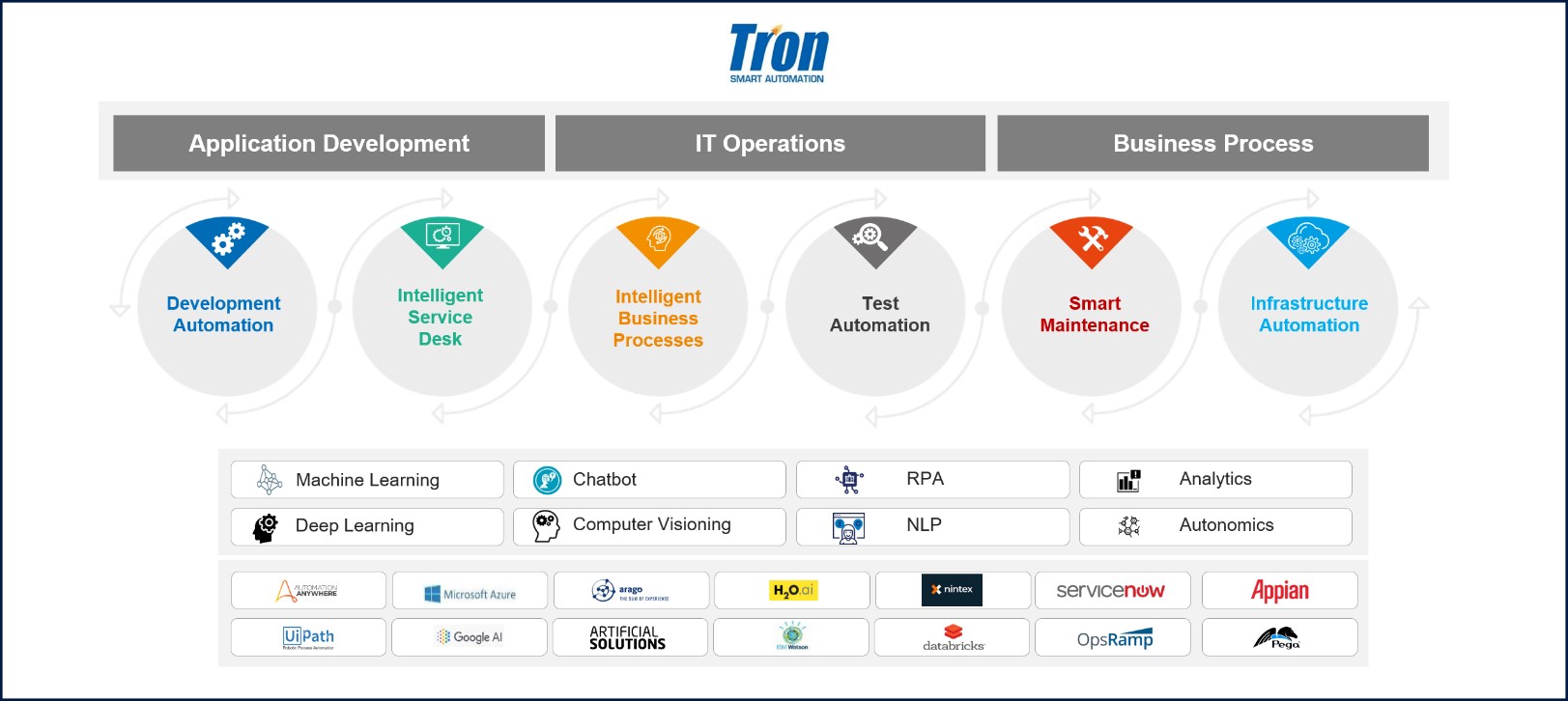
Source: NIIT Technologies
Each of the component modules, such as document extraction or a chatbot, deploys multiple technology components from the core technology elements in the foundational layer. The modules also contain domain data models and assets leveraging domain knowledge and data. For example, the SLICE framework for document extraction leverages various deep learning techniques for text as well as image analysis, across the six steps shown in Exhibit 4.
Exhibit 4: The SLICE framework help in combining foundational components and domain specific models
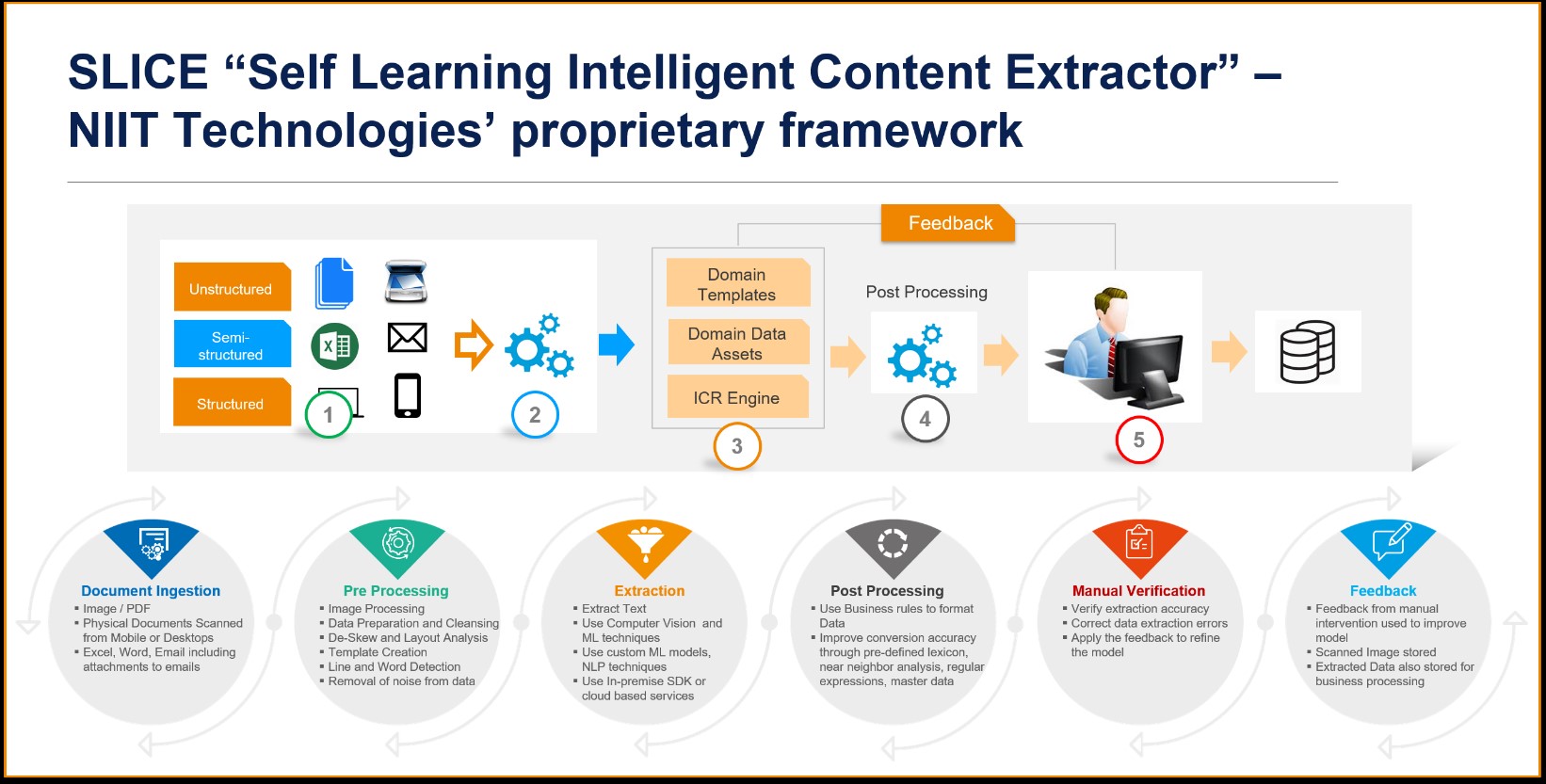
Source: NIIT Technologies
The conversational interface frameworks again reflect the deep understanding and priorities by the domains and verticals, and they center on the user personas in each vertical, as shown in Exhibit 5.
Exhibit 5: Domain-specific intelligent conversation design evolves around the user persona
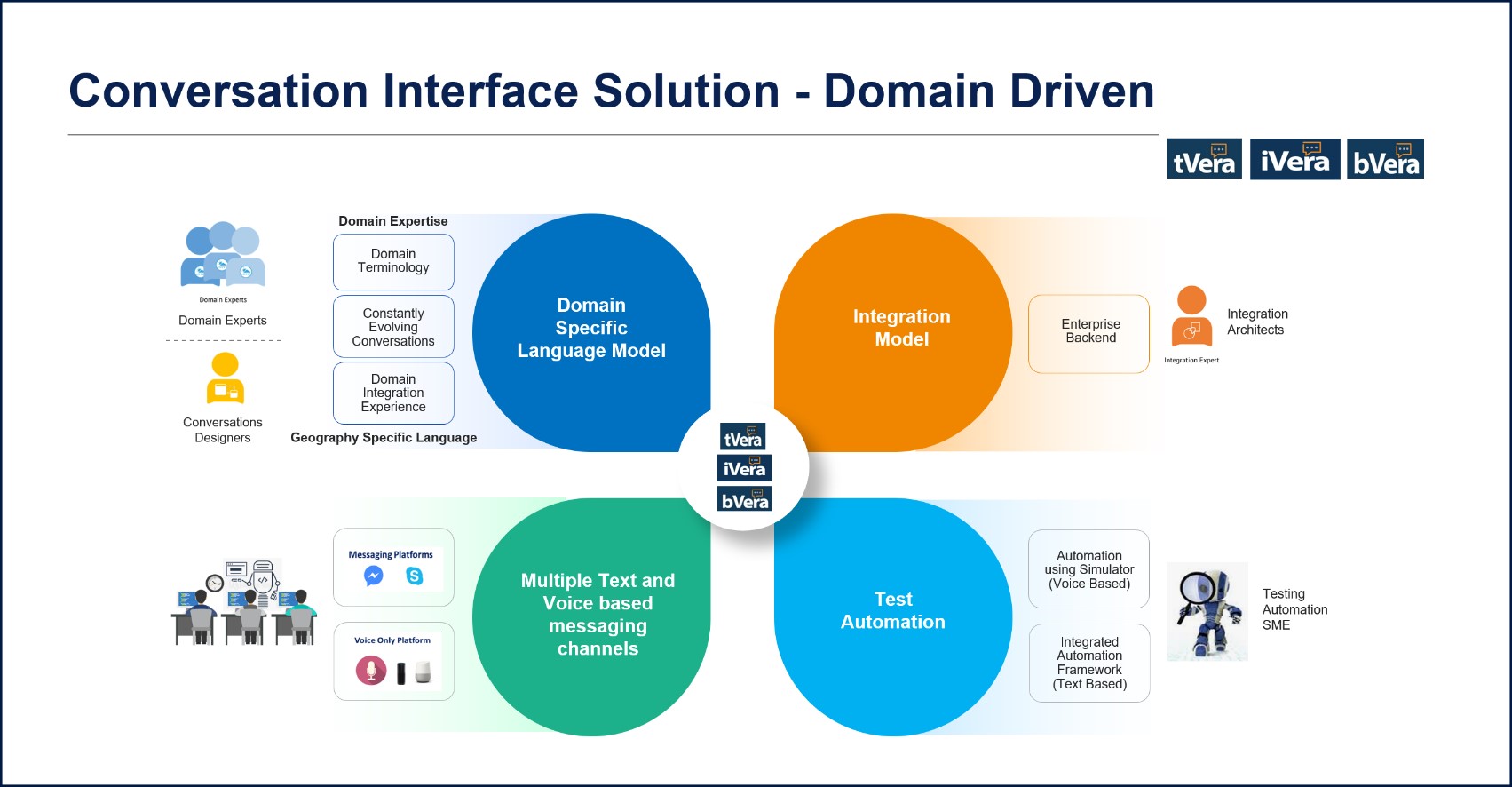
Source: NIIT Technologies
Keeping the user persona at the center of every use case design is the most critical success factor in AI adoption. In the travel and tourism company’s case, for example, during their holidays, the travel company’s customers are directly experiencing every facility, and, therefore, each hour of each day they spend at a facility creates an opportunity for the company to know its customers better. Designing the response management and feedback processing systems around the customers’ persona, therefore, is imperative for an AI-ML use case to be effective in such a context.
The chatbot framework also centers around the user experience across multiple channels and consists of the elements shown in Exhibit 6.
Exhibit 6: Foundational technologies like NLP and cognitive chat along with persona-based design create domain-rich user experience
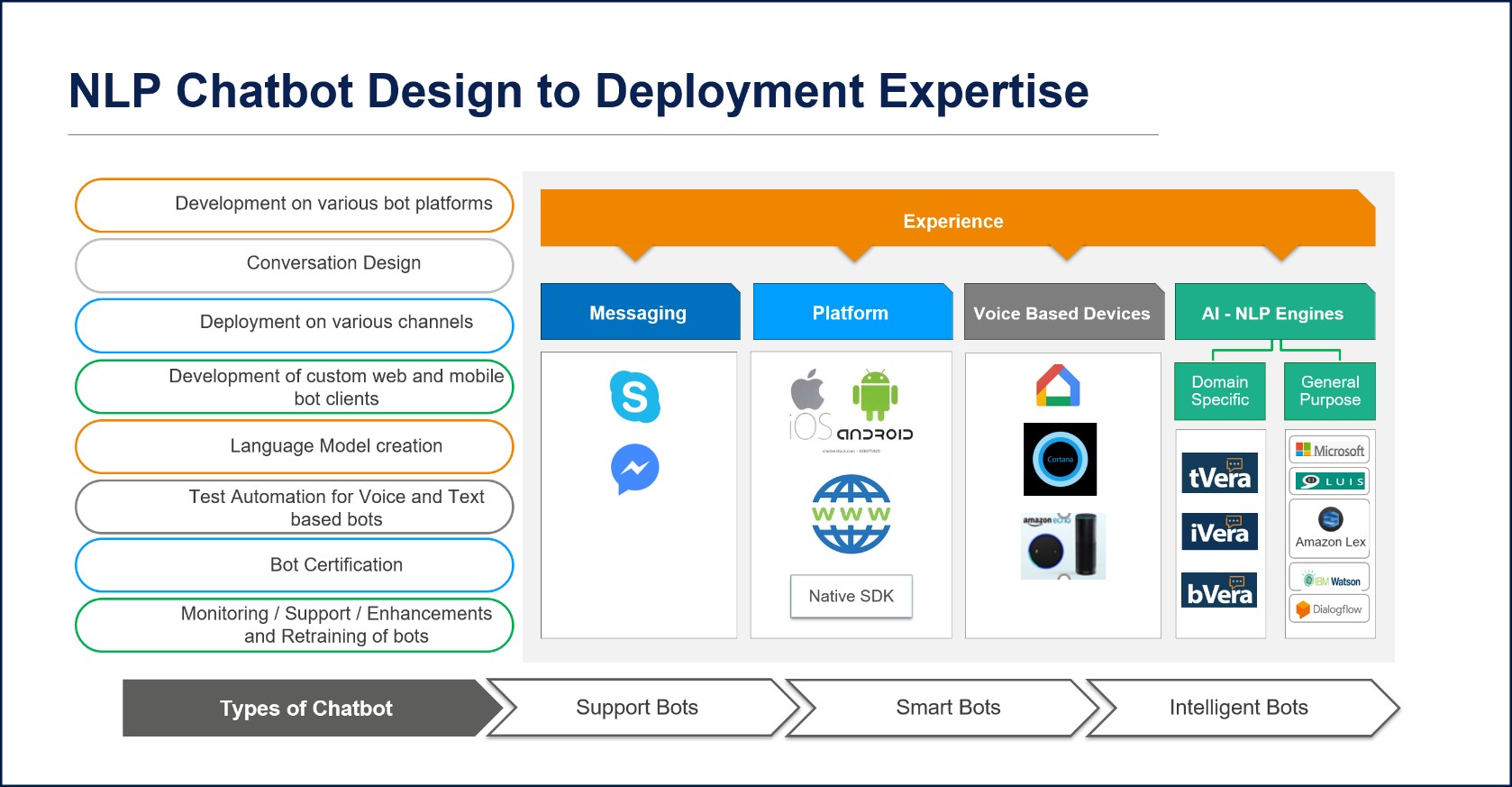
Source: NIIT Technologies
Understanding the vertical and its unique priorities is critical to delivering value with AI: faster and better processes to improve the customer experience.
The customer leader in the global travel company explained how NIIT Technologies’ vertical-focused AI solutioning approach helped them solve data and process management challenges and enabled them to improve their customers’ experience and make effective use of customer feedback, faster and better. The approach and the solutions that NIIT Technologies delivered helped the company achieve real-time customer experience feedback and made the data available for CRM much faster and better. The challenges of dirty and noisy data were resolved in the process by harmonizing relevant data across multiple disparate sources, rendering them available and effective for training the ML models, for example. When it came to the choice of technologies, the NIIT Technologies team showed flexibility thanks to the company’s strong partner ecosystem; for example, the team leveraged Microsoft Vision API’s handwriting recognition modules to read human-written texts in response documents, in combination with multiple open-source AI frameworks that are federated as part of Tron components. The overall approach helped the client company reduce some of their critical process cycle times exponentially. One 70-day end-to-end process was reduced to 10 days, and the turnaround time for an extensive data-processing task shrank from 60 days to just one day. These are outcomes that clients realized on their own operational grounds that helped them achieve transformational and demonstrable business outcomes and top-line impact.
Another senior customer leader from a leading US financial service company, who spoke with us regarding their AI and automation journey with NIIT Technologies, emphasized on this most critical ingredient for the success of AI: solid, strong domain and business understanding from the service provider partner teams. He said their partnership with NIIT Technologies for more than a decade ensured the team’s deep understanding of how their businesses work, what the common work practices are, and what checks and balances there are to keep the overall systems and services stable, consistent, and accurate. He also mentioned how crucial it was for the partner team to evaluate and analyze the starting points, ultimately to stay focused on the business outcomes realized from the multi-faceted programs, rather than just implementing technology and tool stacks. Focus on business outcomes can only come when the partners have an in-depth knowledge of the clients’ critical business priorities and practices. For the clients, nothing else matters more than realizing visible, tangible outcomes, no matter what complex underlying technologies, whether AI or analytics or automation, have gone into delivering them.
The Bottom Line: Enterprise AI leaders must focus on leveraging verticalized AI solutions to practically achieve the exponential gains that these technologies can generate.
AI, analytics, and automation applications are heavily context-focused by design and by definition, given that intelligence itself is very contextual and adaptive. Therefore, to reap the optimal benefits from these technologies, it is imperative that enterprise AI leaders take a verticalized approach and start from the business priorities downward rather than first choosing the technology components and then moving upward. As several customer leaders have shared with us, a technology-first approach doesn’t deliver the value that AI and automation solutions have the potential to generate. Business-first, verticalized approaches are the ones that are helping some of the fast-achieving client leaders beat their competition in the market using AI, and in this journey, it is critical that service provider partners also are equally rich in terms of content and capabilities in the verticals, over and above the obvious requirements of horizontal technical capabilities to build the AI solutions.